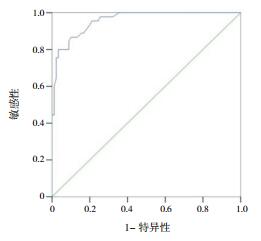 PDF(1437 KB)
PDF(1437 KB)


 PDF(1437 KB)
PDF(1437 KB)
 PDF(1437 KB)
PDF(1437 KB)
PR-957对A1反应性星形胶质细胞形成的影响
Effect of PR-957 on the formation of A1 reactive astrocytes
目的 探讨PR-957对A1反应性星形胶质细胞形成的影响。方法 取出生1 d内的雌性大鼠脑皮质培养出原代星形胶质细胞,将细胞分为对照组、LPS组及LPS+PR-957组。LPS组给予5 μmol/L LPS处理48 h,LPS+PR-957组先用PR-957(终浓度200 nmol/L)处理1 h,再用5 μmol/L LPS处理48 h。采用酶联免疫吸附试验(ELISA)检测补体3(C3,A1反应性星形胶质细胞标记物)和肿瘤坏死因子α(TNF-α);采用实时荧光定量PCR法检测磷脂酰肌醇蛋白聚糖6(glypicans 6,Gpc6)、SPARC样1(SPARC-like 1,Sparcl1)和脂质运载蛋白2(lipocalin 2,lcn2)mRNA的相对表达量。上述各实验均独立重复3次。结果 对照组几乎不表达C3,LPS组与LPS+PR-957组C3水平高于对照组,但LPS+PR-957组的C3水平低于LPS组(P < 0.05)。TNF-α的表达结果与C3一致。与对照组相比,LPS组和LPS+PR-957组的Gpc6 mRNA及Sparcl1 mRNA表达水平均降低,lcn2 mRNA表达水平均升高(P < 0.001);与LPS组相比,LPS+PR-957组的Gpc6 mRNA及Sparcl1 mRNA表达水平均升高,lcn2 mRNA表达水平降低(P < 0.001)。结论 LPS能够诱导星形胶质细胞成为A1反应性星形胶质细胞;PR-957可以抑制LPS诱导的A1反应性星形胶质细胞形成。
Objective To study the effect of PR-957 on the formation of A1 reactive astrocytes. Methods The cerebral cortices of 1-day-old female rats were obtained and cultured for primary astrocytes. These cells were divided into 3 groups:control, lipopolysaccharide (LPS), and LPS+PR-957. The LPS group was treated with LPS (at a concentration of 5 μmol/L) for 48 hours; the LPS+PR-957 group was treated with PR-957 (at a final concentration of 200 nmol/L) for 1 hour and then LPS for 48 hours. Enzyme-linked immunosorbent assay was used to determine the expression of complement 3 (C3, a marker for A1 reactive astrocytes) and tumor necrosis factor alpha (TNF-α). Quantitative real-time PCR was used to determine the relative mRNA expression of glypican-6 (GPC6), SPARC-like 1 (SPARCL1), and lipocalin-2 (LCN2). All the above experiments were repeated three times independently. Results C3 expression was almost not observed in the control group, but was observed in both the LPS group and the LPS+PR-957 group, with significantly lower expression observed in the LPS+PR-957 group (P < 0.05). The expression of TNF-α was consistent with that of C3. Compared with the control group, the LPS and the PS+PR-957 groups had significantly reduced mRNA expression levels of GPC6 and SPARCL1 but significantly increased mRNA expression level of LCN2 (P < 0.001). Compared with the LPS group, the LPS+PR-957 group had significantly increased mRNA expression levels of GPC6 and SPARCL1 but significantly reduced mRNA expression level of LCN2 (P < 0.001). Conclusions LPS can induce the transformation from astrocytes to A1 reactive astrocytes, and PR-957 can inhibit the formation of LPSinduced A1 reactive astrocytes.

脂多糖 / PR-957 / 补体3 / 肿瘤坏死因子α / 星形胶质细胞
Lipopolysaccharide / PR-957 / Complement 3 / Tumor necrosis factor alpha / Astrocyte
[1] Chung WS, Allen NJ, Eroglu C. Astrocytes control synapse formation, function, and elimination[J]. Cold Spring Harb Perspect Biol, 2015, 7(9):a020370.
[2] Sofroniew MV, Vinters HV. Astrocytes:biology and pathology[J]. Acta Neuropathol, 2010, 119(1):7-35.
[3] Liddelow SA, Barres BA. Reactive astrocytes:production, function, and therapeutic potential[J]. Immunity, 2017, 46(6):957-967.
[4] Liddelow SA, Guttenplan KA, Clarke LE, et al. Neurotoxic reactive astrocytes are induced by activated microglia[J]. Nature, 2017, 541(7638):481-487.
[5] Allen NJ, Bennett ML, Foo LC, et al. Astrocyte glypicans 4 and 6 promote formation of excitatory synapses via GluA1 AMPA receptors[J]. Nature, 2012, 486(7403):410-414.
[6] Kucukdereli H, Allen NJ, Lee AT, et al. Control of excitatory CNS synaptogenesis by astrocyte-secreted proteins Hevin and SPARC[J]. Proc Natl Acad Sci U S A, 2011, 108(32):E440-E449.
[7] Livne-Bar I, Lam S, Chan D, et al. Pharmacologic inhibition of reactive gliosis blocks TNF-α-mediated neuronal apoptosis[J]. Cell Death Dis, 2016, 7(9):e2386.
[8] Bi F, Huang C, Tong J, et al. Reactive astrocytes secrete lcn2 to promote neuron death[J]. Proc Natl Acad Sci U S A, 2013, 110(10):4069-4074.
[9] Koerner J, Brunner T, Groettrup M. Inhibition and deficiency of the immunoproteasome subunit LMP7 suppress the development and progression of colorectal carcinoma in mice[J]. Oncotarget, 2017, 8(31):50873-50888.
[10] Basler M, Dajee M, Moll C, et al. Prevention of experimental colitis by a selective inhibitor of the immunoproteasome[J]. J Immunol, 2010, 185(1):634-641.
[11] Muchamuel T, Basler M, Aujay MA, et al. A selective inhibitor of the immunoproteasome subunit LMP7 blocks cytokine production and attenuates progression of experimental arthritis[J]. Nat Med, 2009, 15(7):781-787.
[12] Wagner LK, Gilling KE, Schormann E, et al. Immunoproteasome deficiency alters microglial cytokine response and improves cognitive deficits in Alzheimer's disease-like APPPS1 mice[J]. Acta Neuropathol Commun, 2017, 5(1):52.
[13] Kamphuis W, Kooijman L, Schetters S, et al. Transcriptional profiling of CD11c-positive microglia accumulating around amyloid plaques in a mouse model for Alzheimer's disease[J]. Biochim Biophys Acta, 2016, 1862(10):1847-1860.
[14] Zamanian JL, Xu L, Foo LC, et al. Genomic analysis of reactive astrogliosis[J]. J Neurosci, 2012, 32(18):6391-6410.
[15] McCarthy KD, de Vellis J. Preparation of separate astroglial and oligodendroglial cell cultures from rat cerebral tissue[J]. J Cell Biol, 1980, 85(3):890-902.
[16] Verkhratsky A, Nedergaard M. Physiology of astroglia[J]. Physiol Rev, 2017, 98(1):239-389.
[17] Li S, Uno Y, Rudolph U, et al. Astrocytes in primary cultures express serine racemase, synthesize d-serine and acquire A1 reactive astrocyte features[J]. Biochem Pharmacol, 2018, 151:245-251.
[18] Pekny M, Pekna M, Messing A, et al. Astrocytes:a central element in neurological diseases[J]. Acta Neuropathol, 2016, 131(3):323-345.
[19] Mazdeh M, Moradi N, Khoshroo E, et al. Down-regulation of TYK2, CBLB and LMP7 genes expression in relapsingremitting multiple sclerosis patients treated with interferonbeta[J]. J Neuroimmunol, 2018, 314:24-29.
[20] Guo Y, Chen X, Li D, et al. PR-957 mediates neuroprotection by inhibiting Th17 differentiation and modulating cytokine production in a mouse model of ischaemic stroke[J]. Clin Exp Immunol, 2018, 193(2):194-206.
国家自然科学基金(81571466)。